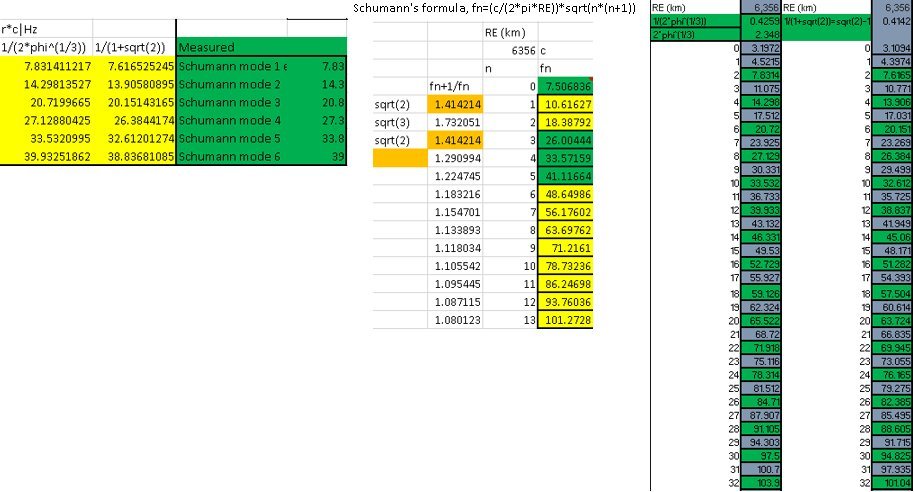Indistinguishable superpositions plague LIGO and other sensitive experiments. Filtering unwanted spectral power must be tempered with empirical weight, given unpredictable dispersion, and new resonant modes subsequently, which produces nonlinear deviations of >2 Hz from empirical mean. A mode series generated from a modulus or mean between multiple valid first principles operations may or may not include a relativistic term to capture enhancements and variance may suffice for the application of an optimal filter.
By locating a realistic minimal group propagation rate, Schumann's formula converges with measured values
r=1/(2φ^(1/3))=0.42589
or
r=1/(1+ √2)=0.41421.
https://www.degruyter.com/downloadpdf/j/zna.1952.7.issue-2/zna-1952-0202/zna-1952-0202.pdf
(cf.[(v=0.71 c=√2/2=1/√2)*(γ=1.414...=√2)]=1, v|γ=[v=1/✓2≡0.70710678118]|[γ[✓2] ≡1.41421356237);
Precision non-empirical Schumann peaks: v|c:≈0.43, r=1/(2φ^(1/3))=0.42589... f0=(rc/(2πRE)) fn=(rc/(2πRE))√(n(n+1)), for n2,n4,...

√2, √3 interband scaling from Schumann formula [1952],

0.88 c as mean value for global lightning-induced ELF propagation velocity (applied from Schumann resonance transients and the search for gravitational waves):
[equivalent formula ln(1+√2)=0.88137358702]
1/√(0.88*0.56)≈√2
2-(0.88*0.43)≈φ
(1/√(0.88*0.56))/(2-(0.88*0.43))=0.87845782298
√2/φ=0.87403204889
0.87845782298/2=0.43922891149
0.87403204889/2=0.43701602444
LIGO GW150914 remnant ringdown freq, ~250 Hz
LIGO GW150914 frequency/wavelength for peak strain, 150 Hz/2000 km
GW150914 0.2 s duration, event cycle wavelength 40172 km at 0.67 c, 7.5 Hz|v≅0.67 c (7.5 Hz approx. ideal fundamental Schumann mode at Earth radius 6356 km, 0.67 remnant spin mean, with respect to c, for all LIGO-Virgo sources); 5 Hz|v=c, 59958 km|0.2 s
Lorentz factor, γ=1/(√(1-(v2/c2))
group velocity, vg
(0.0069*c)=2068.6 km, (0.0069*[0.67*c])=1385.9 km
c/((0.0069*c)*0.58)=249.88 Hz;
0.72-0.57=0.15, 1/0.15=6.666...
0.71-0.58=0.13
0.72-0.56=0.16
(1/√2)-(1/√3)=0.12975651199
(1/√22 )-(1/√32)=0.166666...
(recall that [(v=0.71 c=√2/2=1/√2)*(γ=1.414...=√2)]=1):
(t=0.01 s)/(γ=1.441|vg=0.72c)=0.00694 s
1/
(t=0.01 s)/(γ=1.44225|vg=0.72059 c)=0.006934 s
https://fulguritics.blogspot.com/2020/06/extreme-conservation-of-constants-for.html
v=1, 813 km*(2*π)=5108.229655 km=58.68813234 Hz
v=0.68, 1094 km (0.5*(3000-813 km))*π=3435.33 km=59.3418328 Hz